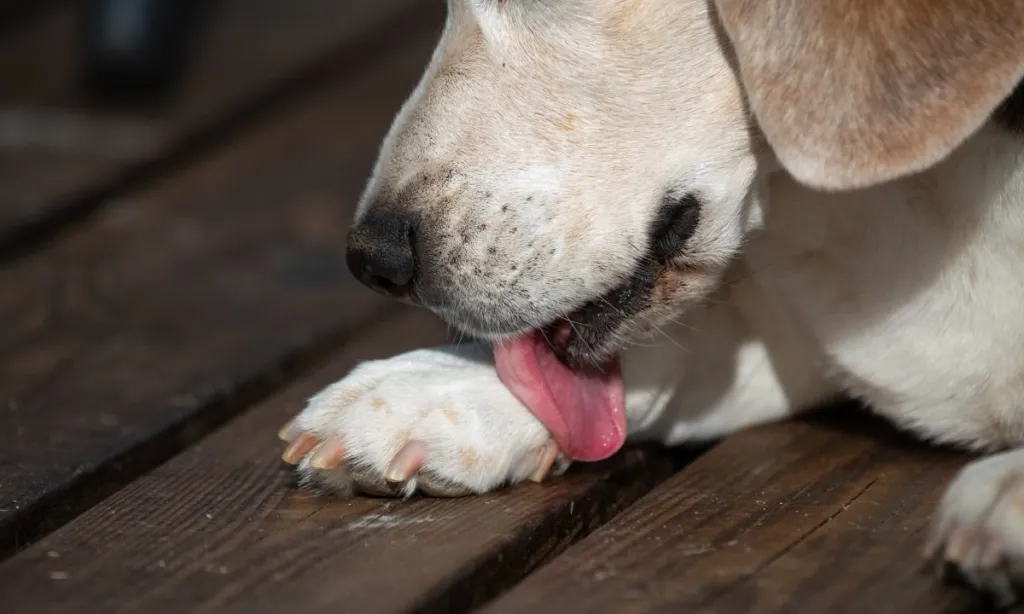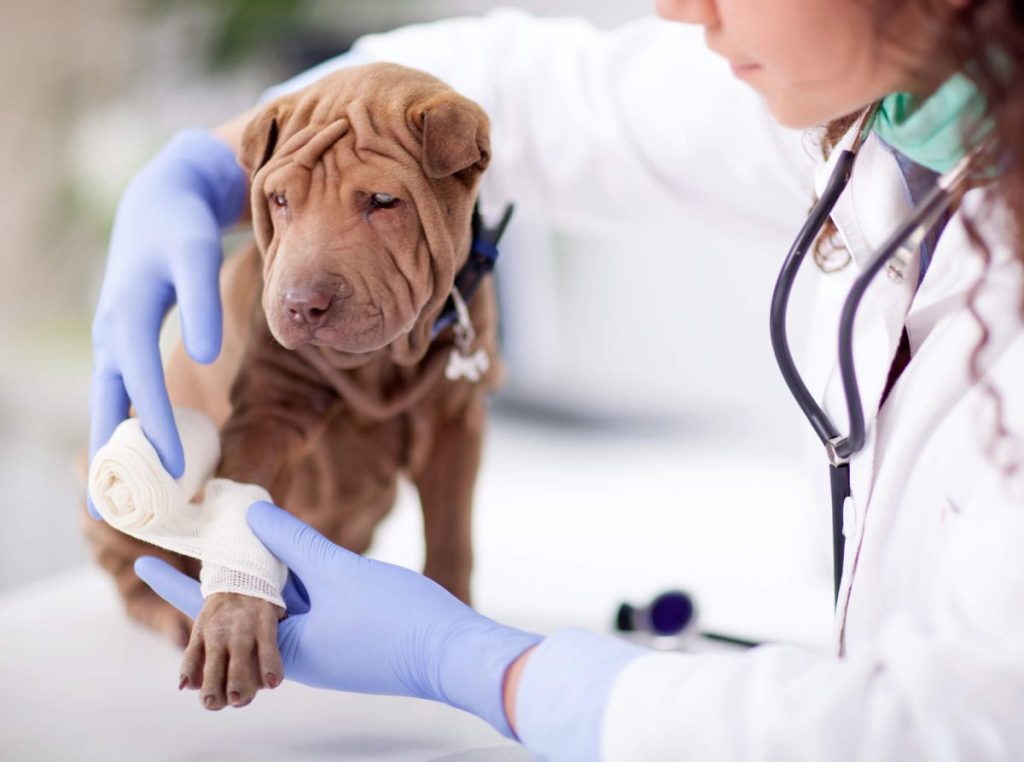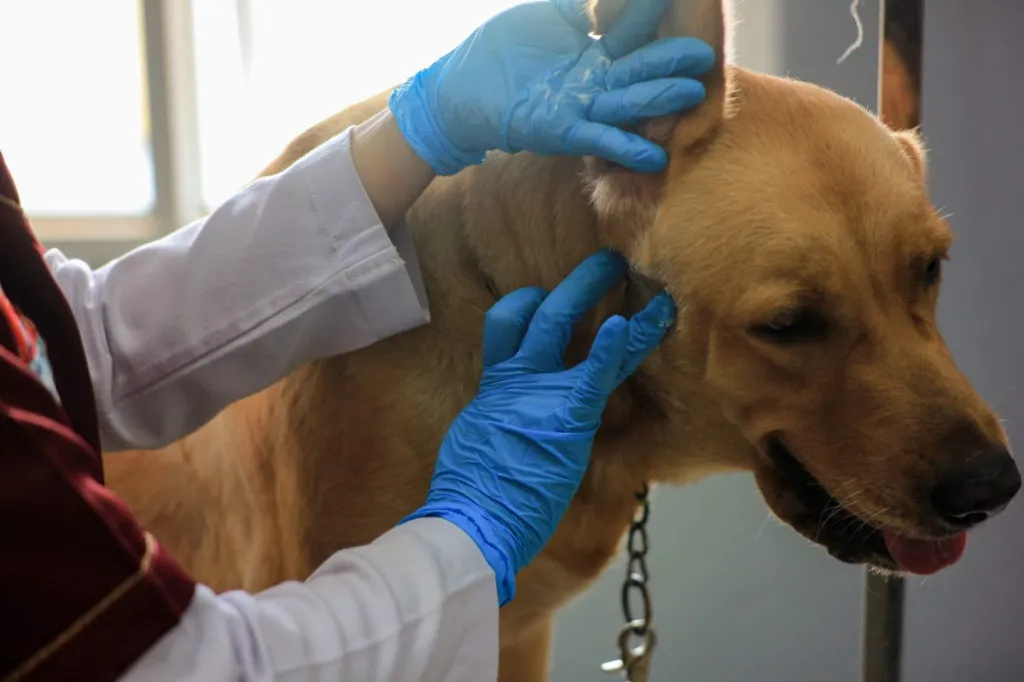Abscesses in dogs are localized pockets of pus that form in response to infections. They occur when the body’s immune system works to contain bacteria or other harmful pathogens that enter through a wound or infected area. While abscesses can develop anywhere on — or even inside — a dog’s body, they are most commonly found in regions more prone to injury, such as the head, neck, limbs, and base of the tail. Essentially, an abscess is the body’s way of isolating an infection to prevent it from spreading to other areas.
Here’s what you should know about the symptoms, causes, and treatments for abscesses in dogs.
Symptoms of abscesses in dogs

An abscess can manifest through various symptoms — which might be subtle or quite pronounced — depending on the severity and location of the infection. Here are some common signs to look out for:
- Visible swelling and redness
- Pain and sensitivity
- Heat in the affected area
- Pus or fluid discharge
- Lethargy
- Loss of appetite
- Fever
- Excessive licking or chewing at the site
- Foul odor
- Changes in behavior
- Swollen lymph nodes
It is important to note that an abscess may sometimes be mistaken for a cyst due to their similar appearance. However, the two have different underlying causes and characteristics. Cysts are usually non-infectious and filled with fluid or other material. They develop gradually and are generally painless unless they grow large or rupture. Cysts can form due to blocked hair follicles, oil glands, or other benign conditions. In contrast, abscesses are caused by infections. They are typically painful, swollen, and may cause systemic symptoms such as fever and lethargy. An abscess often requires medical treatment to drain the pus and address the underlying infection.
Causes of abscesses in dogs

Abscesses in dogs are usually the result of bacterial infections, most often involving Staphylococcus spp., Streptococcus spp., or Escherichia coli. These bacteria can enter the dog’s body through several routes, including:
- Bite wounds: One of the most common causes of abscesses in dogs is bite wounds from other animals. When a dog gets into a fight with another dog or animal, the puncture wounds created by teeth can introduce bacteria deep into the tissue. The body’s immune response to these bacteria can result in the formation of an abscess.
- Foreign objects: Dogs are naturally curious and sometimes get foreign objects like thorns, splinters, or grass awns embedded in their skin. If these objects are not promptly removed, they can become a breeding ground for bacteria, leading to an abscess.
- Injuries and trauma: Injuries from accidents, such as being struck by a car or getting caught in a fence, can cause damage to the dog’s skin and underlying tissues. If bacteria enter these wounds, an abscess can form.
- Dental issues: Dental disease can lead to abscesses at the root of a tooth — known as tooth root abscesses. These are typically very painful and can cause swelling around the face or jaw.
- Anal gland infections: Dogs have two anal glands located near their rectum, which can sometimes become blocked or infected. If these glands aren’t expressed as needed, they can form painful abscesses that may rupture without timely treatment.
- Post-surgical infections: Occasionally, dogs can develop abscesses at surgical sites if the area becomes contaminated by bacteria during or after the surgery.
Dog breeds more susceptible to developing abscesses
While any dog can develop an abscess, certain breeds are more susceptible due to their unique physical traits or lifestyles. Some of them are:
Treatments for abscesses in dogs

If you’ve noticed a swollen, painful lump on your dog, it could be an abscess. As such, it’s crucial to visit the vet for a professional diagnosis to ensure your dog receives proper treatment. The vet will likely perform a physical examination and may recommend tests such as a fine needle aspiration (FNA) or a culture to identify the bacteria causing the infection.
One of the most common treatments for an abscess is draining it. Your vet will make an incision to allow the pus to drain out. This procedure relieves pressure and pain while helping to clear the infection. It’s usually done under sedation or anesthesia to keep your dog comfortable. The vet will also clean the area thoroughly to remove any debris and bacteria. After the abscess is drained, your dog may require antibiotics and pain relievers to manage discomfort, as well as to prevent the infection from spreading. Be sure to follow your vet’s instructions carefully when administering these medications.
Furthermore, you’ll need to continue caring for your pet’s wound at home. Keep the area clean and dry, and monitor it for any signs of recurring infection, like redness, swelling, or discharge. Your vet may recommend cleaning the wound with a saline solution or a prescribed antiseptic. It’s essential to prevent your dog from licking or biting the wound, as this can introduce more bacteria and delay healing. Using an Elizabethan collar can help keep your dog from disturbing the area.
Once your dog receives appropriate treatment and care, their abscess may start to show improvement within two to three days. Full healing typically takes one to two weeks. In more severe cases — especially if surgery is required — recovery could take longer, potentially several weeks.
Can a dog’s abscess heal on its own?
In some cases, minor abscesses may rupture and drain on their own, leading to spontaneous healing. However, this is not always the case, and relying on natural remedies alone can be risky. Untreated abscesses can result in serious infections and other complications. For instance, if an internal abscess ruptures, it can spread bacteria to other organs and throughout the body. This is why seeking prompt veterinary care is important to ensure abscesses are treated properly and complications are avoided.
To reduce the risk of future abscesses, keep your dog’s environment clean and free of hazards that could cause injuries. Regular grooming can also help you spot and address minor wounds before they become infected. If your dog frequently interacts with other animals, keep a close eye on them for any bite wounds or scratches, as these can easily develop into abscesses.









